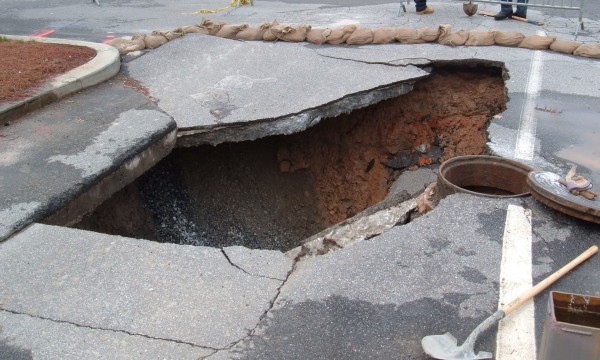What Is Causing The Sinkhole Epidemic?

Why sinkholes are appearing in higher numbers around parts of the UK. Why they form, the difference between natural and man-made types and how property is likely safe.
There are any number of graphic images and videos online of deep holes sometimes mere feet from property, in people’s gardens, in busy city streets and even in the middle of motorway carriageways. These often huge sinkholes are causing chaos both in the UK and around the world.
What’s especially frightening is the way they can appear without warning – videos online capture dramatic footage of sinkholes suddenly opening up in the ground like something from a disaster film. They’re often not small cavities either – some are huge and easily as deep as a double decker bus.
It’s basically a cavity that forms under the surface of the ground. Once it becomes large enough so the ground above is no longer supported, the top surface gives way revealing the often huge hole beneath.
Strictly speaking, all the holes appearing aren’t necessarily sinkholes. Certain types are formed by rock beneath the surface naturally being worn or eroded to a point where it can no longer support the ground above. A typical way the rock beneath being removed is by water erosion – and the heavy rainfalls and flooding in recent times coupled with the acidic quality of certain rainwater exacerbates the formation of sinkholes.
The other type of cavity is formed by previous manmade activity such as underground mining compromising the ground beneath the surface. Geologists term these as a ‘dene’ or ‘crown hole’.
Some sink holes (such as that pictured) have been caused by rainwater leaking through pavements and carrying soil into ruptured sewer pipes. Maintaining drainage channels is one way to prevent sinkholes in urban environments.
Certain rock types are especially vulnerable to erosion by water; areas covered by chalk, limestone and gypsum are especially prone to sinkholes. This is why many sinkholes have appeared in the South-East; along with the heavy rainfall experienced in the area in the recent past, large swathes of the area are covered by chalk which is a highly soluble rock.
Areas of Yorkshire are also covered in chalk but due to the area having been covered by glaciers many times in the past the chalk there tends to be more resilient to sinkhole formation than the softer type found in the South-East.
Some areas suffer sinkholes caused by a combination of vulnerable rock and manmade causes. Areas around the Pennines, North and South Wales and parts of Cumbria are covered with highly soluble limestone, and these areas also have many disused mines to add to the risk.
While there’s no doubt sinkholes are becoming more common, they’re by no means a modern phenomenon. Ripon in North Yorkshire has one of the oldest sinkholes in the UK – it first appeared in 1834 and remains today.
Hundreds of years ago the more superstitious people considered sinkholes as direct routes to hell – indeed one near Darlington in the North East dating back to the 12th century is called Hell’s Kettle.
While water eroding rock underneath the surface is a sinkhole risk, so is extracting water for irrigation or mining purposes. Water being drained out of cavities deep beneath the ground cause the rock to collapse, and this has caused some huge sinkholes in other parts of the world.
Guatemala City is built on especially soft volcanic rock and has been called the ‘Sinkhole Capital’ of the world.
Many might worry that they’ll suddenly see a big sinkhole underneath their property. The risk is less likely as roofs obviously repel the water and guttering directs it away; it’s the ground nearby that is more at risk hence sinkholes appearing by the side of property rather than directly underneath.
Fraser Ruthven is the Marketing Associate for London Drainage Facilities, one of London’s leading drainage companies. London Drainage provides a wide range of drainage diagnostic and repair services in and around London.
